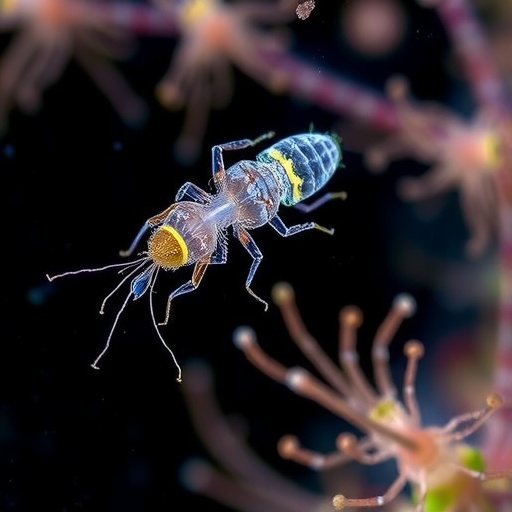In a groundbreaking international study published in Limnology and Oceanography Letters, researchers have uncovered compelling evidence that the tiny planktonic crustaceans known as copepods harbor unique microbial communities that more accurately trace ocean currents and environmental gradients than free-living microbes in seawater. This discovery offers unprecedented insight into the mechanisms governing marine microbial distribution and suggests a new biological lens through which to monitor the health and dynamics of marine ecosystems in a changing climate.
Copepods are among the most abundant metazoans in oceanic ecosystems, representing a crucial trophic link between primary producers and higher predators. Despite their ecological importance, the microbial communities associated with these crustaceans have remained understudied relative to free-living planktonic microbes. The team, led by Prof. Tamar Guy-Haim and Dr. Ximena Velasquez from the Israel Oceanographic and Limnological Research institute, embarked on an ambitious expedition across the Mediterranean Sea to systematically characterize the microbiomes of copepods and how they reflect the ocean’s dynamic environmental landscape.
The Mediterranean was a natural choice for this research due to its stark west-to-east gradients in temperature, salinity, and nutrient availability, providing a natural experimental framework to tease apart the influences of oceanographic conditions on microbial biogeography. Over the course of five weeks aboard the research vessel L’Atalante, the team collected samples ranging from the nutrient-rich western basin near France to the oligotrophic eastern basin close to Crete. This extensive sampling under the logistical challenges imposed by the COVID-19 pandemic allowed the researchers to generate a comprehensive dataset that integrates host-associated microbial diversity with precise environmental metadata.
The researchers applied state-of-the-art genetic sequencing techniques to profile microbial communities attached to copepods and those freely suspended in seawater from the same sampling stations. Their analyses revealed that copepod-associated microbial communities exhibit distinct biogeographic structuring that mirrors ocean current patterns and environmental gradients to a far greater degree than free-living microbes. This finding challenges the conventional view that marine microbial distributions are primarily driven by widespread dispersal and environmental selection acting on free-living populations.
Dr. Velasquez explained, “The microbes found on copepods do not just drift aimlessly; instead, they travel intimately with their hosts, which move in accordance with ocean currents and environmental conditions. This host-mediated dispersal creates a complex microbial meta-community that essentially maps the physical and chemical contours of the marine environment.” The intricate relationship between hosts and microbes, therefore, generates spatial patterns that more precisely capture the connectivity and compartmentalization within oceanic basins.
Moreover, the study emphasized that free-living microbes tend to be dominated by cosmopolitan species capable of thriving across diverse conditions, which results in relatively homogeneous distributions. In contrast, copepod microbiomes were composed of more specialized taxa influenced by both host traits, such as diet and feeding behavior, and environmental constraints imposed by ocean circulation. This dual influence offers a more nuanced view of microbial ecology, where biotic interactions and physical oceanography converge to shape community composition.
Prof. Guy-Haim highlighted the significance of these microbial metacommunities, noting, “At a local scale, individual copepod species harbor specific microbial consortia determined by host biology, but across large marine regions, these communities integrate through host migrations and environmental exchanges, forming a cohesive metacommunity. This opens new avenues to study microbial connectivity and ecosystem resilience in marine systems.”
The research leveraged sophisticated evolutionary models and comparative analyses to demonstrate that copepod microbiomes in Mediterranean basins connected by currents shared high similarity, whereas those in isolated basins were distinct. Such patterns reinforce the importance of ocean circulation as a barrier or conduit for microbial dispersal when mediated by animal hosts, contrasting sharply with patterns observed in the free-living microbial fraction.
This host-associated microbial signature not only provides a biological proxy for mapping physical oceanographic features but also emerges as a promising bioindicator for detecting ecological changes, especially under the specter of climate change. As surface ocean temperatures rise and nutrient regimes shift towards more oligotrophic conditions, these specialized microbiomes may respond more sensitively and rapidly than bulk seawater microbial communities.
The practical applications of this discovery are compelling. By monitoring copepod microbiomes, scientists could gain early warnings of ecosystem perturbations such as warming, acidification, or shifts in biogeochemical cycling. This could substantially improve our capacity to manage and protect vulnerable marine habitats, fisheries, and biodiversity hotspots by providing a high-resolution biological signal integrated over space and time.
The success of this ambitious international collaboration, spanning Israel, Italy, Greece, and France, underscores the value of multidisciplinary approaches combining oceanography, microbial ecology, evolutionary biology, and advanced genomics. The concerted effort aboard L’Atalante exemplifies how in situ sampling, even during a global pandemic, remains irreplaceable for grounding molecular studies in precise environmental contexts.
Looking forward, this study lays the groundwork for expanded investigations into other marine host-microbiome systems, potentially including fish, gelatinous plankton, and benthic invertebrates. Understanding how host mobility, behavior, and physiology shape microbial landscapes will be pivotal in comprehending ocean ecosystem function and resilience amid accelerating environmental change.
In sum, the revelation that copepod-associated microbes serve as living tracers of oceanic currents and environmental gradients offers a powerful new tool for marine science. This microbiome-centric perspective bridges physical oceanography and biological complexity, promising transformative advances in ecosystem monitoring and our fundamental understanding of microbial biogeography. As climate impacts intensify, such integrative approaches are essential to safeguard the vast and vital microbial networks underpinning life in the ocean.
Subject of Research: Not applicable
Article Title: Copepod-associated microbial biogeography in the epipelagic ocean
News Publication Date: 13 August 2025
Web References:
- https://aslopubs.onlinelibrary.wiley.com/doi/10.1002/lol2.70054
- http://dx.doi.org/10.1002/lol2.70054
References:
Velasquez et al. (2025), Limnology and Oceanography Letters
Image Credits: Dr. Ximena Velasquez
Keywords: copepod microbiome, marine microbial biogeography, ocean circulation, microbial metacommunity, Mediterranean Sea, plankton, host-associated microbes, environmental gradients, climate change bioindicators




